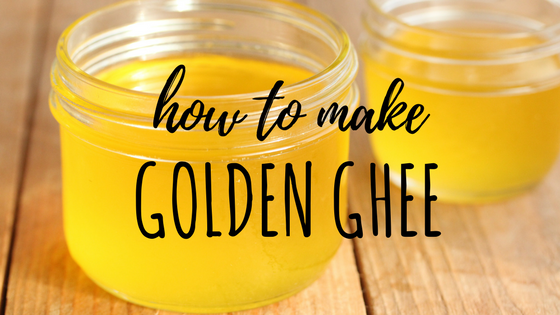By Hayley Stobbs R.Ac., CNC
Ghee is made with unsalted butter that has been gently cooked then skimmed and strained of milk solids. Simmering butter at a low temperature allows separation to occur; the water evaporates, the lactose coagulates, and the protein settles to the bottom. You know you’ve created ghee when the sunken milk solids have turned golden in colour and as your kitchen fills with a wonderful aroma.
As inflammatory compounds are removed using the following method it becomes tolerable for those with dairy intolerance. According to TCM diet therapy, ghee is warming, sweet, enters the spleen and stomach meridian, and nourishes yin and jing. In Ayurvedic medicine ghee is considered a tridoshic food, meaning that it is suitable for all constitutions. It aids in the lubrication of all tissues of the body, especially the intestinal tract. According to ayurvedic practitioner, Dr. Vasant Lad, “Ghee is a nourishing digestive. It helps to improve absorption, assimilation, improves memory and makes the body flexible. Ghee pacifies pitta and vata and is acceptable, in moderation, for kapha.”
Ghee contains small amounts of vitamin A, D, E, K, CLA, butyric acid, and beta-carotene. Please choose grass-fed/pastured butter to make your ghee, which ensures presence of these nutrients. Also, keep in mind that toxins accumulate in fat tissues, which is another reason why to buy butter from pasture-raised cows.
Once made, ghee can be kept indefinitely at room temperature and is said to improve with age, has a high smoke point, and does not require refrigeration. Do not to tamper the ghee with a dirty or wet spoon, as this will encourage bacterial build-up.
“The golden keys to health lie in getting in touch with your inner self and in seeing the process of healing as a useful means of learning about your own unique needs.” – Dr. Vasant Lad
Cook time: 15 – 20 minutes
Makes: 2 cups
Ingredients: 1 lb. grass fed butter
Directions:
1. Place the pound of butter in a small saucepan. Melt and bring to a simmer over medium heat, uncovered. Immediately turn the heat to medium low, so that the heat is just enough to maintain a light simmer
2. Gently simmer for approximately 20 minutes— length of time varies depending on unique stovetop manufacturing and seasonal temperature. Do not cover or stir.
3. Skim and discard the foam that rises to the top with a spoon.
4. The milk solids will float to the bottom of the saucepan and they will turn golden in colour — keep an eye out and make sure they don’t burn. Warning: they burn fast!
5. Immediately strain through a fine sieve that is layered with cheesecloth into a wide glass measuring cup. Or, use a nut milk bag that is draped over a fine sieve. Discard the milk solids.
Pour into 2, 1, or ½ cup glass mason jars. Leave a portion out on your countertop and refrigerate the rest.

